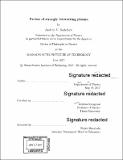| dc.contributor.advisor | Krishna Rajagopal. | en_US |
| dc.contributor.author | Sadofyev, Andrey V | en_US |
| dc.contributor.other | Massachusetts Institute of Technology. Department of Physics. | en_US |
| dc.date.accessioned | 2017-10-30T15:30:16Z | |
| dc.date.available | 2017-10-30T15:30:16Z | |
| dc.date.copyright | 2017 | en_US |
| dc.date.issued | 2017 | en_US |
| dc.identifier.uri | http://hdl.handle.net/1721.1/112072 | |
| dc.description | Thesis: Ph. D., Massachusetts Institute of Technology, Department of Physics, 2017. | en_US |
| dc.description | Cataloged from PDF version of thesis. | en_US |
| dc.description | Includes bibliographical references (pages 123-138). | en_US |
| dc.description.abstract | In this thesis we discuss recent results on the medium/probe interaction in the strongly coupled plasma produced in heavy-ion collisions. Such processes involve physics at multiple energy scales making a consistent theoretical description challenging. We show how insights from various regimes can be combined to extend our understanding of the underlying physics. As a first example, we start with the novel contributions to the drag force acting on a heavy quark moving through the strongly coupled holographic plasma. The new terms are proportional to the coefficient of the axial anomaly and to the chiral asymmetry in the medium. These chiral contributions to the drag force act either parallel to or antiparallel to an external magnetic field or to the vorticity of the fluid. We show that the chiral drag force vanishes for heavy quarks that are at rest in a suitably chosen frame in the weak field limit. In this frame, the heavy quark at rest sees counter propagating momentum and charge currents, both proportional to the axial anomaly coefficient, but feels no drag force. This provides strong concrete evidence for the absence of dissipation in chiral transport. Then, we extend this result introducing a concept of an "anomalous wind" felt by probes at rest. This phenomenon modifies previous results on the medium/probe interaction. We demonstrate that by deriving the anomalous correction to the screening length of the heavy quarkonium color potential. Finally, we discuss the strong magnetic field limit to the leading order in the weak medium/probe coupling. It is shown that the drag force is suppressed along the magnetic field and in the exact chiral limit tends to zero. This anisotropy in the drag force is present in the system even at zero chiral asymmetry and may lead to strong observable effects. Then, we turn to the main available probes of the plasma produced in experiments - jets. We supplement the holographic description corresponding to the infinite medium/probe coupling limit with an initial parameter distribution for an ensemble of jets motivated by the weakly coupled dynamics and similar to the case of proton-proton collisions. The model constructed in this way, combining insights from both weakly and strongly coupled regimes, is used to analyze the evolution of an ensemble, as it propagates through an expanding cooling droplet of strongly coupled plasma as in heavy ion collisions. Each jet in the ensemble is represented holographically by a string in the dual 4 + 1-dimensional gravitational theory. Firstly, the full string dynamics is approximated by assuming that the string moves at the speed of light. We study the evolution of the jet opening angle distribution upon propagating the droplet and study the medium effect on the mean opening angle within a simple two parametric phenomenological model. Then, we extend this result analyzing the full string dynamics for a range of possible initial conditions. That gives access to the dynamics of holographic jets just after their creation. We analyze the full jet shape modification and find the result that the jet shape scales with the opening angle at any particular energy. Further, we construct an ensemble of dijets with energies and energy asymmetry distributions taken from events in proton-proton collisions and jet shape taken from proton-proton collisions and scaled according to our result. We study how these observables are modified after the ensemble of dijets is propagated through the strongly-coupled plasma. The results of this simple model is in qualitative agreement with the experimental data. | en_US |
| dc.description.statementofresponsibility | by Andrey V. Sadofyev. | en_US |
| dc.format.extent | 138 pages | en_US |
| dc.language.iso | eng | en_US |
| dc.publisher | Massachusetts Institute of Technology | en_US |
| dc.rights | MIT theses are protected by copyright. They may be viewed, downloaded, or printed from this source but further reproduction or distribution in any format is prohibited without written permission. | en_US |
| dc.rights.uri | http://dspace.mit.edu/handle/1721.1/7582 | en_US |
| dc.subject | Physics. | en_US |
| dc.title | Probes of strongly interacting plasma | en_US |
| dc.type | Thesis | en_US |
| dc.description.degree | Ph. D. | en_US |
| dc.contributor.department | Massachusetts Institute of Technology. Department of Physics | |
| dc.identifier.oclc | 1006739287 | en_US |
